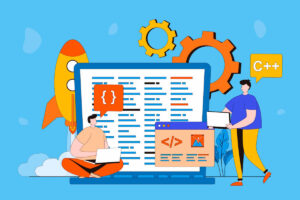Laravel is a popular PHP framework that is widely used for developing web applications. It provides a robust set of tools and features that make it easy to build secure, scalable, and maintainable software. If you are new to Laravel software development or looking to enhance your skills, this guide will provide you with everything you need to know to get started.
What is Laravel?
Laravel is an open-source PHP framework that follows the MVC (Model-View-Controller) architectural pattern. It was created by Taylor Otwell and released in 2011. Laravel provides a clean and elegant syntax that allows developers to write code quickly and efficiently.
Laravel stands out among other PHP frameworks due to its rich feature set, including a powerful ORM, robust authentication system, expressive routing engine, and seamless database migration tools. This combination of features makes Laravel a top choice for developers looking to streamline their development process and create high-quality web applications.
When working with Laravel, developers can take advantage of its modular structure, which allows for easy integration of third-party libraries and components. This modularity not only simplifies the development process but also ensures that applications built with Laravel are flexible and easily maintainable.
Laravel’s vibrant community is another key aspect that sets it apart from other frameworks. The community actively contributes to the framework’s development, provides support through forums and tutorials, and continuously updates the framework with new features and enhancements.
Why Choose Laravel for Software Development?
There are several reasons why Laravel is a popular choice for software development:
- Ease of Use: Laravel provides a simple and intuitive syntax that makes it easy to learn and use. This lowers the barrier to entry for new developers and allows experienced developers to work more efficiently.
- Modularity: Laravel comes with a wide range of built-in modules and libraries that can be easily integrated into your project. This modularity promotes code reusability and helps developers create scalable applications.
- Security: Laravel provides built-in protection against the most common security vulnerabilities, such as SQL injection, cross-site scripting, and cross-site request forgery. This ensures that applications built with Laravel are secure by default.
- Community Support: Laravel has a large and active community of developers who contribute to the framework and provide support to beginners. This community-driven approach ensures that developers have access to resources and assistance when building applications with Laravel.
Getting Started with Laravel
To start developing software with Laravel, you will need to install the framework on your local machine. You can do this using Composer, a dependency management tool for PHP. Here are the steps to install Laravel:
- Install Composer on your machine if you haven’t already done so. Composer is a powerful tool that simplifies the management of PHP dependencies and allows you to easily install Laravel and its dependencies.
- Open a terminal window and run the following command to create a new Laravel project:
composer create-project --prefer-dist laravel/laravel projectName
This command will download the latest version of Laravel and set up a new project with the specified name. - Once the installation is complete, navigate to the project directory and start the development server using the following command:
php artisan serve
This command will start a development server that allows you to preview your Laravel application in a web browser.
By following these steps, you can quickly set up a new Laravel project and start developing web applications with this powerful framework.
Key Features of Laravel
Laravel comes with a wide range of features and tools that make it easy to develop high-quality software. Some of the key features of Laravel include:
- Eloquent ORM: Laravel provides an elegant ActiveRecord implementation called Eloquent, which makes it easy to work with databases. Eloquent simplifies database interactions by allowing developers to define relationships using expressive syntax.
- Blade Templating Engine: Laravel comes with a powerful templating engine called Blade, which allows you to write clean and reusable templates. Blade templates are compiled into plain PHP code, making them fast and efficient.
- Routing: Laravel provides a simple and expressive way to define routes for your application. Routes can be defined using a closure-based syntax or by using controller classes.
- Middleware: Laravel middleware allows you to filter HTTP requests entering your application. Middleware can be used to perform tasks such as authentication, logging, and request validation.
- Authentication: Laravel comes with built-in authentication and authorization features that make it easy to implement user authentication. Laravel’s authentication system includes user registration, login, password reset, and role-based access control.
By leveraging these key features of Laravel, developers can build robust and scalable web applications that meet the needs of their users.
Best Practices for Laravel Development
When developing software with Laravel, it is important to follow best practices to ensure that your code is clean, maintainable, and secure. Some best practices for Laravel development include:
- Use Eloquent Relationships: Take advantage of Eloquent relationships to define relationships between your database tables. Eloquent relationships simplify the process of working with related data and ensure data consistency.
- Validation: Always validate user input to prevent security vulnerabilities and ensure data integrity. Laravel provides a powerful validation system that allows developers to define validation rules for incoming data.
- Use Helper Functions: Laravel provides a wide range of helper functions that can help you write cleaner and more concise code. These helper functions cover common tasks such as string manipulation, array operations, and file handling.
- Testing: Write unit tests to ensure that your code works as expected and to catch any bugs early on. Laravel provides support for PHPUnit, a popular testing framework for PHP, which makes it easy to write and run tests for your Laravel applications.
By incorporating these best practices into your Laravel development workflow, you can create high-quality software that is reliable, secure, and easy to maintain.
Conclusion
In conclusion, Laravel is a powerful PHP framework that is well-suited for developing web applications. By following the best practices outlined in this guide and taking advantage of Laravel’s key features, you can build secure, scalable, and maintainable software that meets the needs of your users. Happy coding!
This article is written by an SEO content writing expert fluent in English.
FAQs:
What is Laravel?
Laravel is an open-source PHP framework that follows the MVC (Model-View-Controller) architectural pattern. It provides a clean and elegant syntax for developers to write code quickly and efficiently.
Why Choose Laravel for Software Development?
Laravel is a popular choice for software development due to its ease of use, modularity, security features, and active community support.
How do I get started with Laravel?
To start developing software with Laravel, you will need to install the framework on your local machine using Composer. Follow the steps outlined in the guide to create a new Laravel project and start the development server.
What are some key features of Laravel?
Laravel comes with key features such as Eloquent ORM for working with databases and Blade Templating Engine for writing efficient and reusable code.












+ There are no comments
Add yours